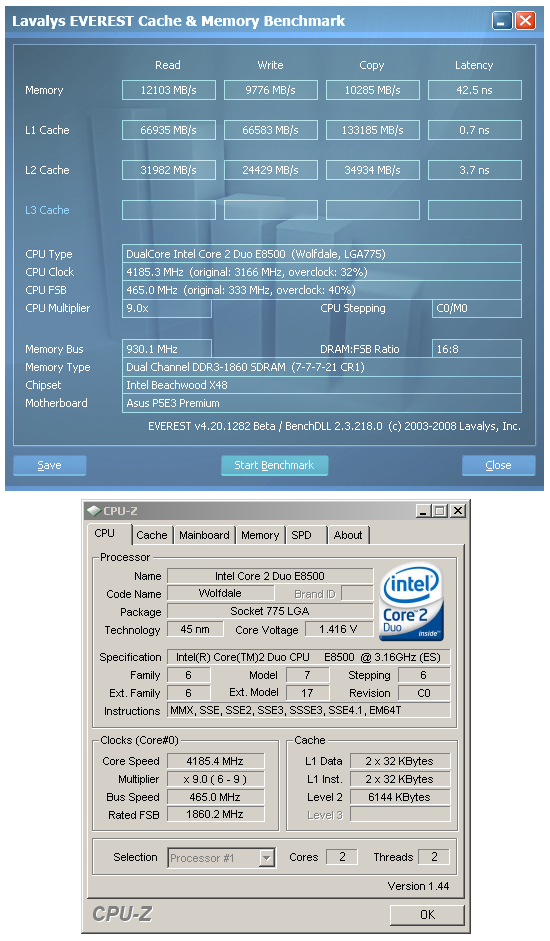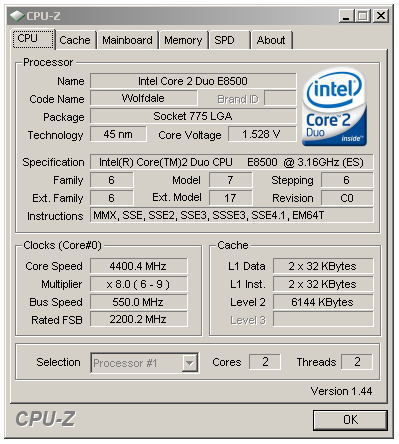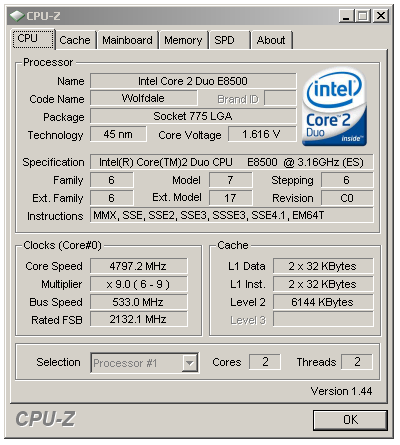ASUS P5E3 Premium: One to Rule them All…
by Kris Boughton on February 20, 2008 12:15 AM EST- Posted in
- Motherboards
Memory Overclocking

These are some of the highest memory read scores and lowest latencies we have ever seen on an Intel chipset. This is exactly where DDR3 starts to show its real power.
It's hard to argue with the performance potential this system brings at these settings, something that current X38 users might find impossible when aiming for total stability. Perhaps the most impressive point in this accomplishment is that our MCH required only 1.35V in order to run hour after hour of Prime95 or other stress tests without error. There are those that may believe this is not much to speak of, but the combination of high CPU speed and low tRD is brutal on the MCH - something we plan to explore soon in great detail. In fact, this is exactly where the X48 chipset begins to shine - in some of the situations where the X38 would either fall flat on its face or require voltages well in excess of those we feel comfortable using on a daily basis.
CPU Overclocking
 While 4.5GHz on a 45nm dual-core might not seem that impressive, we were able to get this system stable at these settings with water-cooling alone. Click to view Prime95 in action. |
The typical 45nm dual-core usually tops out around 4.0 to 4.2GHz on water-cooling or air-cooling alone, at least when it comes to achieving a truly stable overclock. Getting our E8500 sample to 4.5GHz stable took a little patience and a lot more Vcore than we feel comfortable using. Nevertheless, we ran Prime95 here for days while keeping temperatures under control (about 55C maximum in a 20C room). Most people who overclock knows just how difficult this can be.
Again, we must give a lot of credit in the success of this overclock to the power of the X48 chipset. This is also a great demonstration of ASUS' ability to design a very capable VRM circuit. Current draw under full-load at these speeds is impressive to say the least. Any other less capable power delivery design probably would have gone down in a blaze of glory (we had several in the labs that did just that trying to keep up with this board). This all just goes to show that although not specifically built for gaming per say, the P5E3 Premium is more than capable of keeping up with ASUS' very own R.O.G. line of motherboards. (Ed: Now if we could just do something about the lack of SLI….)
FSB Wars: Return of the Stupid-High Screenshot

For the general bemusement of the FSB crowd, we decided to include a screenshot of our board's maximum FSB using stock cooling and respectable voltages. While higher FSB speeds may be achievable, we can hardly imaging using them at this point. Intel's 45nm dual-core speed binning process promises to play a much more active role in the release of all future CPUs. Those that think they are going to pay for a budget chip and then turn around and overclock it to the same speeds as top-end Extreme CPUs are in for a rude awakening based on our early retail results. Keep in mind that our absolute maximum stable overclock was barely made using a multiplier less than the E8500's stock 9.5x value and you should begin to see one reason why these uber-high FSB speeds are just plain unneeded.

No quick look at overclocking performance would be complete without the obligatory maximum CPU frequency suicide-run screenshot. Just what the maximum achievable frequency was had more to do with our nerves than anything else. Given the voltage, our E8500 was more than happy to continue scaling ever higher. At some point though we said enough is enough and called it quits - that point came when we saw that we were subjecting our poor 45nm CPU to over 1.6V, simply a voltage that will require your credit card to be handy for another CPU in short time. Quite simply, we believe any voltage over 1.45V is asking for danger on the 45nm processors and conversations with Intel seem to back-up our beliefs right now. Our only solace is that we were quick when it came to gathering these results.










32 Comments
View All Comments
lopri - Wednesday, February 20, 2008 - link
I do not know the exact procedure or metrics for Editor's Choice award, but isn't it a little to early for a 'Gold' award? I don't even know if there are any other X48 board exist.And there is no mention of usability, or how well the included features all perform, or there is not even a single benchmark performed other than Everest shot. Indeed, it looks like the award was given simply because the reviewer was so impressed soley by the board's overclocking performance.
kjboughton - Wednesday, February 20, 2008 - link
To date was have reviewed the following Intel X48 boards: Gigabyte GA-X48T-DQ6, ASUS R.O.G. Rampage Formula, MSI X48 Platinum and ASUS P5E3 Premium, which can all be found by navigating to the 'Motherboards' tab linked at the top of this page. Although we are certainly prepared to review any other boards that come forward, no other company has officially announced the existence of their X48-based product(s) at this time.DBissett - Wednesday, February 20, 2008 - link
The specifications list DDR2 dividers....should that be DDR3?pnyffeler - Wednesday, February 20, 2008 - link
I've been reading Anandtech for almost a decade now, and I've watched the fanboys, haters, and gurus go back and forth on lots of issues.Instead of talking about the substance of the article, I just wanted to say that you folks run the best online hardware review page on the planet, and this article is yet another example of the incredible work you do. Your attention to detail is impressive, but your genuine concern for getting to the bottom of issues and telling the readers how you really feel. That level of honesty breeds trust, which is a difficult commodity to come by in today's online world.
Keep up the excellent work.
takumsawsherman - Wednesday, February 20, 2008 - link
Thank God! I was afraid that Asus was going to use Firewire800 instead of 400. Make sure you keep using the 10 year old variant of the technology, ok Asus? Whatever you do, do not spend the couple of extra bucks to improve the speed of the interface. Heck, while you're at it, for a $250 board, why don't you just take away firewire altogether, and replace it with onboard video. That would be class.LEKO - Wednesday, February 20, 2008 - link
Because manu people have a digital camera with FireWire output. For some (like me), I based my decision on FireWire availability... A board without FireWire is an handicapped board for me.takumsawsherman - Wednesday, February 20, 2008 - link
I was being sarcastic. I use many firewire devices, mostly 400, some 800. It irks me that manufacturers insist on me buying 3rd party cards, even at this incredibly high price for a motherboard.They just want Firewire to go away so they can add a little to their margins.
Visual - Wednesday, February 20, 2008 - link
I wonder how the situation will play out in the laptop segment. nVidia's chipsets have a feature that is very promising in that segment - namely their now non-optional integrated graphics card in combination with an addon card, and the ability to switch between the two without rebooting.My understanding is that all intel laptops so far are always made with an intel chipset (to qualify for their centrino brand), so we likely won't be able to benefit from these exciting features of the new nvidia chipsets. This is a shame.
Alex1180 - Wednesday, February 20, 2008 - link
If I wanted to pair this mobo with the upcoming Q9450 what would be the best air cooling heatsink/fan solution to overclock the CPU and what speed would you recommend overclocking it to?any help would be appreciated
Super Nade - Wednesday, February 20, 2008 - link
Hi,None of those caps are Nichion. The VRM caps are Fujitsu FP-Cap and the one by the EPS connector looks like a Sanyo SEPC.